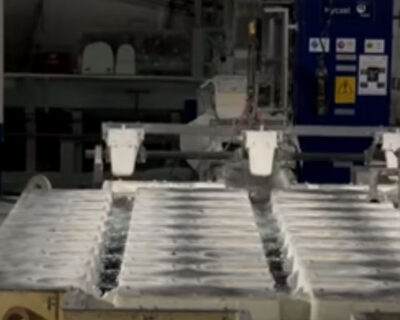Reasonable 6063 aluminum alloy casting temperature is also an important factor for producing high-quality aluminum rods. If the temperature is too low, casting defects such as slag inclusions and pinholes are easy to occur. If the temperature is too high, casting defects such as coarse grains and feather crystals are easy to occur.
6063 Aluminum Alloy Casting
Control Casting Temperature
After the grain refinement treatment of the 6063 aluminum alloy liquid, the casting temperature can be appropriately increased, and can generally be controlled between 720-740 ° C. Because:
①Aluminum liquid becomes sticky after grain refinement treatment, easy to solidify and crystallize.
②Aluminum rod has a liquid-solid two-phase transition zone at the crystallization front during casting, and a higher transition temperature has a narrow transition zone. The excessive transition zone is conducive to the escape of gas discharged from the crystallization front. Of course, the temperature should not be too high The casting temperature will shorten the effective time of the grain refiner and make the grains relatively large.
Preheat Casting System
When conditions permit, fully preheat and dry casting systems, such as launders and distributing plates, so as to prevent the reaction of moisture with aluminum liquid to cause hydrogen absorption.

Avoid Turbulence of Liquid Aluminum
During 6063 aluminum alloy casting, avoid the turbulence and rolling of the aluminum liquid as much as possible. Do not easily stir the aluminum water in the flow groove and the distribution plate with tools, allow the aluminum liquid to flow smoothly into the crystallizer under the protection of the surface oxide film. Because the tool agitates the aluminum liquid, and the liquid flow turns to rupture the oxide film on the surface of the aluminum liquid, causing new oxidation. At the same time, the oxide film is rolled into the aluminum liquid. Studies have shown that the oxide film has a very strong adsorption capacity, it contains 2% moisture. When the oxide film is involved in the aluminum liquid, the water in the oxide film reacts with the aluminum liquid, causing hydrogen absorption and slag inclusion.
Aluminum Liquid Filtration
Molten aluminum filtration is the most effective method to remove non-metallic slag in aluminum liquid. In the casting of 6063 aluminum alloy, it is generally filtered with multi-layer glass wire cloth or ceramic foam filter plate. In order to ensure that the aluminum liquid can be filtered normally, the aluminum liquid should remove the surface scum before filtering. Because the surface scum is easy to block the filter mesh of the filter material, so that the filtration cannot be performed normally. The simplest way is to set a slag blocking plate in the launder.

